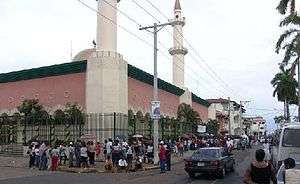Islam in Panama

According to a 2009 Pew Research Center report, there are 24,000 Muslims in Panama who constitute 0.7 percent of the population.[1]
Early history
The first Muslims in Panama were African slaves from the Mandinka tribe, brought by the Spaniards to work the gold mines in 1552.[2] The Mandinka were Muslims, and their importation was prohibited by Spanish Laws but was violated nonetheless. A group of about 500 that arrived on the Atlantic coast of Panama in 1552, escaped from a sinking ship. They elected a man called Bayano (Vaino) as their leader in the fight against the colonizers. They formed councils, and mosques in the areas now known as Darién Province, Bay of San Miguel, San Blas Islands and the area along the Bayano River, named after Bayano. Bayano gained truces with Panama's colonial governor, but the well known Commander Pedro de Ursúa successfully captured the guerrilla leader, who was sent to Peru and then Spain where he died. After Bayano's death, efforts were made to destroy any trace of Islam during that period in Panama. There is no history as what happened to the Muslims who remained in Panama.
Modern Period
The second wave of Muslims were single-male immigrants from the Indian subcontinent and Lebanon who arrived from 1904 to 1913 and later married local women. The first mosque was built by the Ahmadiyya Muslim movement, in 1930.[3] In 1929 another group came from Bombay, India who went on to form the Sunni Indo-Pakistani Muslim Society. From 1929-1948 this organization (renamed Panama Muslim Mission) initiated construction on a mosque in Panama City. The location was half completed and was used for Eid prayers and classes for new Muslims, who numbered about twenty-five blacks of West Indian descent. There was also another group practicing Islam in Colón led by a Jamaican named Basil Austkan, who rented a place for salat on 6th Street and Broadway. In 1932 there was a group of Muslim in San Miguel, Calidonia in Panama City who resided in Short Street where they held meetings and prayers. The Muslims in Panama City of Indo-Pakistan origins had no family structure until 1951 when the first families arrived. In 1963, they purchased a plot in the local cemetery called Jardin de Paz; in 1991, property was purchased in an area called Arraijan, which is now used solely as a Muslim cemetery.
Community Development: 1970s to Present
In the mid-1970s some native Panamanians influenced by the Nation of Islam and led by Abdul Wahab Johnson and Suleyman Johnson, began propagating Islam in Panama City and Colón. After meeting with Dr. Abdulkhabeer Muhammad they began to study orthodox Sunni Islam. In 1977 they received financing from Arab merchants in Colon to rent a place on 7th Street and Central Avenue, Colón. This group, due to lack of knowledge and assistance, eventually disintegrated. The Indo-Pakistani Muslims began teaching their children at home in 1965 until 1973, when a small teaching program began in a room above Bazar Hindustan on Central Avenue, Panama City. In 1978, they began to use a place in the area of Perejil, Panama City, where prayers and meetings took place until the completion of the El Centro Cultural Islámico de Colón on January 15, 1982. This masjid was built jointly by the Islamic Call Society (based in Libya) and Salomon Bhikhu a local merchant from India. Since its inauguration, classes have been held in the evenings and Sundays for new Muslims and people interested in Islam, given by Dr. Abdulkhaber Muhammad and in his absence Hamza Beard. In 1991 the Muslim community purchased in Arraiján, which is now used solely as a Muslim cemetery. As of March 1997, there were four mosques Panama.
See also
- Religion in Panama
- KUSUMO, Fitra Ismu, "ISLAM EN AMERICA LATINA Tomo I: La expansión del Islam y su llegada a América Latina (Spanish Edition)"
- KUSUMO, Fitra Ismu, "ISLAM EN AMÉRICA LATINA Tomo II: Migración Árabe a América Latina y el caso de México (Spanish Edition)"
- KUSUMO, Fitra Ismu, "ISLAM EN AMÉRICA LATINA Tomo III: El Islam hoy desde América Latina (Spanish Edition)"
Sources
- Dr. Fernando Romero el Rey Bayano y Los Negros Panameños en los mediados del siglo xvi
- The Message: Canada Islamic Magazine August 1997
References
- ↑
- ↑ Islam Outside the Arab World by David Westerlund, Ingvar Svanberg, pg. 452
- ↑ Ingvar Svanberg, David Westerlun. Islam outside the Arab world. Routledge. ISBN 0-7007-1124--4. Retrieved May 6, 2014.
